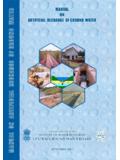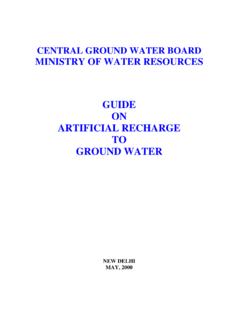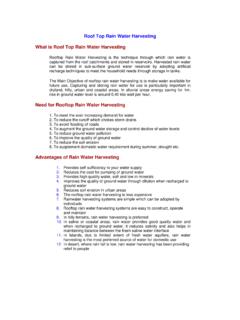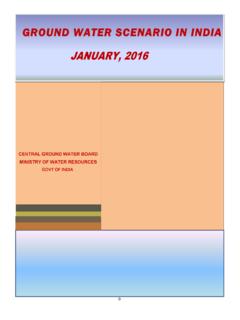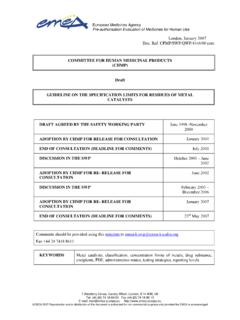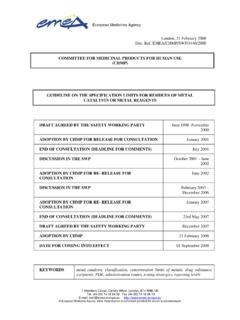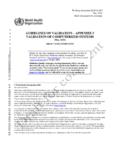Transcription of ihus dk ikuh fof'kfV - Central Ground Water Board
1 IS 10500 : 2012. Hkkjrh; ekud ihus dk ikuh fof'kf"V. nwljk iqujh{ . Indian Standard DRINKING Water SPECIFICATION. ( Second Revision ). ICS BIS 2012. BUREAU OF INDIAN STANDARDS. MANAK BHAVAN, 9 BAHADUR SHAH ZAFAR MARG. NEW DELHI 110002. May 2012 Price Group 6. Drinking Water Sectional Committee, FAD 25. FOREWORD. This Indian Standard (Second Revision) was adopted by the Bureau of Indian Standards, after the draft finalized by the Drinking Water Sectional Committee had been approved by the Food and Agriculture Division Council. This standard was originally published in 1983.}
2 A report prepared by the World Health Organization in cooperation with the World Bank showed that in 1975, some 1 230 million people were without safe Water supplies. These appalling facts were Central to the United Nations decision to declare an International Drinking Water Supply and Sanitation decade, beginning in 1981. Further, the VI Five-Year Plan of India had made a special provision for availability of safe drinking Water for the masses. Therefore, the standard was formulated with the objective of assessing the quality of Water resources, and to check the effectiveness of Water treatment and supply by the concerned authorities.
3 The first revision was undertaken to take into account the up-to-date information available about the nature and effect of various contaminants as also the new techniques for identifying and determining their concentration. Based on experience gained additional requirements for alkalinity; aluminium and boron were incorporated and the permissible limits for dissolved solids, nitrate and pesticides residues modified. As per the eleventh five year plan document of India (2007-12), there are about lakh quality affected habitations in the country with more than half affected with excess iron, followed by fluoride, salinity, nitrate and arsenic in that order.
4 Further, approximately, 10 million cases of diarrhoea, more than lakh typhoid cases and lakh viral hepatitis cases occur every year a majority of which are contributed by unclean Water supply and poor sanitation. The eleventh five year plan document of India (2007-2012) recognizes dealing with the issue of Water quality as a major challenge and aims at addressing Water quality problems in all quality affected habitations with emphasis on community participation and awareness campaigns as well as on top most priority to Water quality surveillance and monitoring by setting up of Water quality testing laboratories strengthened with qualified manpower, equipments and chemicals.
5 The second revision was undertaken to upgrade the requirements of the standard and align with the internationally available specifications on drinking Water . In this revision assistance has been derived from the following: a) EU Directives relating to the quality of Water intended for human consumption (80/778/EEC) and Council Directive 98/83/EC. b) USEPA standard National Primary Drinking Water Standard. EPA 816-F-02-013 dated July, 2002. c) WHO Guidelines for Drinking Water Quality. 3rd Edition Vol. 1 Recommendations, 2008. d) Manual on Water Supply and Treatment, third edition revised and updated May 1999, Ministry of Urban Development, New Delhi.
6 This standard specifies the acceptable limits and the permissible limits in the absence of alternate source. It is recommended that the acceptable limit is to be implemented as values in excess of those mentioned under Acceptable' render the Water not suitable. Such a value may, however, be tolerated in the absence of an alternative source. However, if the value exceeds the limits indicated under permissible limit in the absence of alternate source' in col 4 of Tables 1 to 4, the sources will have to be rejected. Pesticide residues limits and test methods given in Table 5 are based on consumption pattern, persistence and available manufacturing data.
7 The limits have been specified based on WHO guidelines, wherever available. In cases where WHO guidelines are not available, the standards available from other countries have been examined and incorporated, taking in view the Indian conditions. In this revision, additional requirements for ammonia, chloramines, barium, molybdenum, silver, sulphide, nickel, polychlorinated biphenyls and trihalomethanes have been incorporated while the requirements for colour, turbidity, total hardness, free residual chlorine, iron, magnesium, mineral oil, boron, cadmium, total arsenic, lead, polynuclear aromatic hydrocarbons, pesticides and bacteriological requirements have been modified.
8 In this revision, requirement and test method for virological examination have been included. Further, requirements and test methods for cryptosporidium and giardia have also been specified. Routine surveillance of drinking Water supplies should be carried out by the relevant authorities to understand the risk of specific pathogens and to define proper control procedures. The WHO Guidelines for Drinking Water Quality, 3rd Edition, Vol. 1 may be referred for specific recommendations on using a Water safety approach incorporating risk identification.
9 Precautions/Care should be taken to prevent contamination of drinking Water from chlorine resistant parasites such as cryptosporidium species and giardia. IS 10500 : 2012. Indian Standard DRINKING Water SPECIFICATION. ( Second Revision ). 1 SCOPE 4 REQUIREMENTS. This standard prescribes the requirements and the Drinking Water shall comply with the requirements methods of sampling and test for drinking Water . given in Tables 1 to 4. The analysis of pesticide residues given in Table 3 shall be conducted by a recognized 2 REFERENCES laboratory using internationally established test method The standards listed in Annex A contain provisions meeting the residue limits as given in Table 5.
10 Which through reference in this text, constitute Drinking Water shall also comply with bacteriological provisions of this standard. At the time of publication, requirements (see ), virological requirements the editions indicated were valid. All standards are (see ) and biological requirements (see ). subject to revision and parties to agreements based on this standard are encouraged to investigate the Bacteriological Requirements possibility of applying the most recent editions of the standards indicated in Annex A. Water in Distribution System 3 TERMINOLOGY Ideally, all samples taken from the distribution system including consumers' premises, should be free from For the purpose of this standard the following definition coliform organisms and the following bacteriological shall apply.


